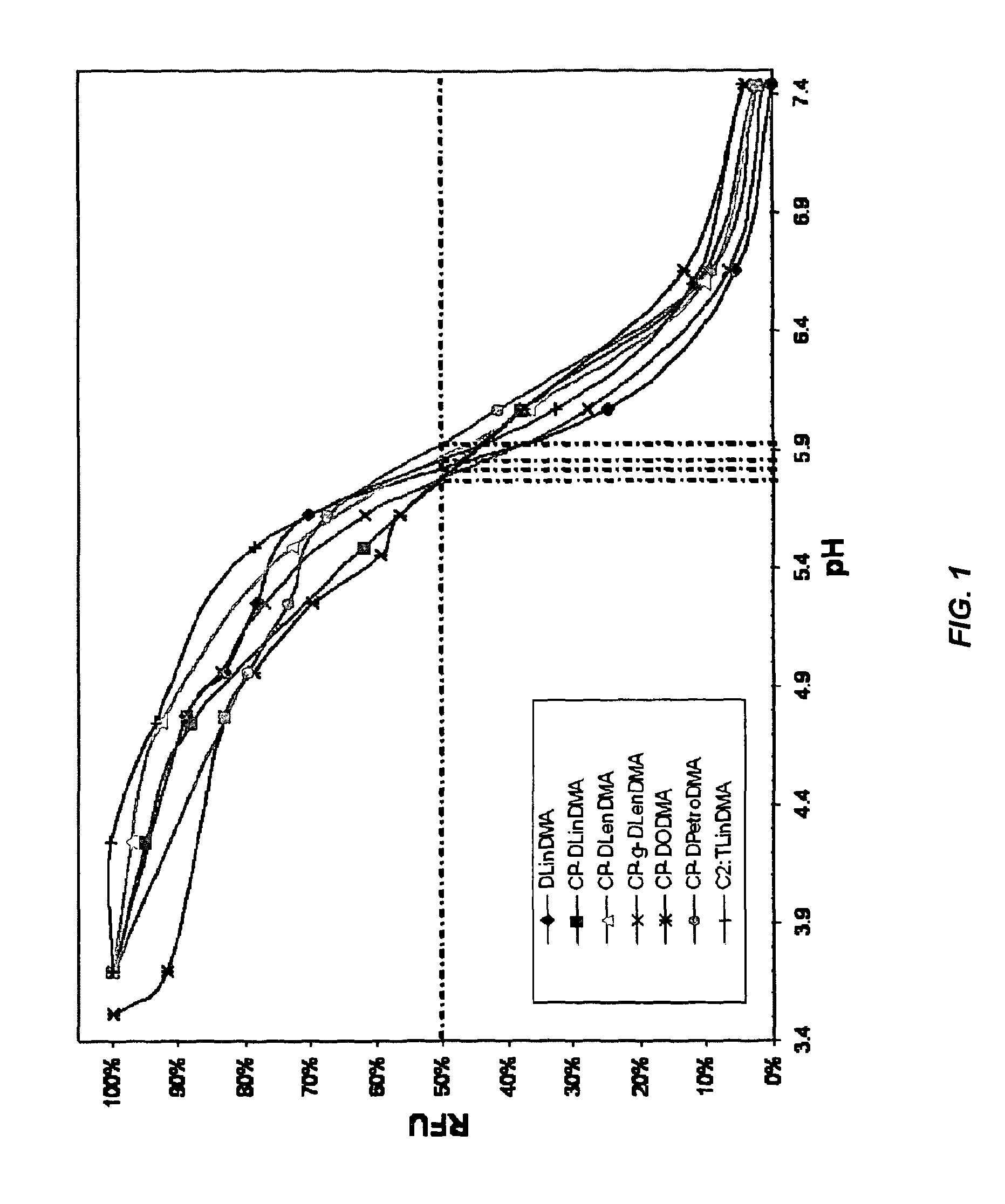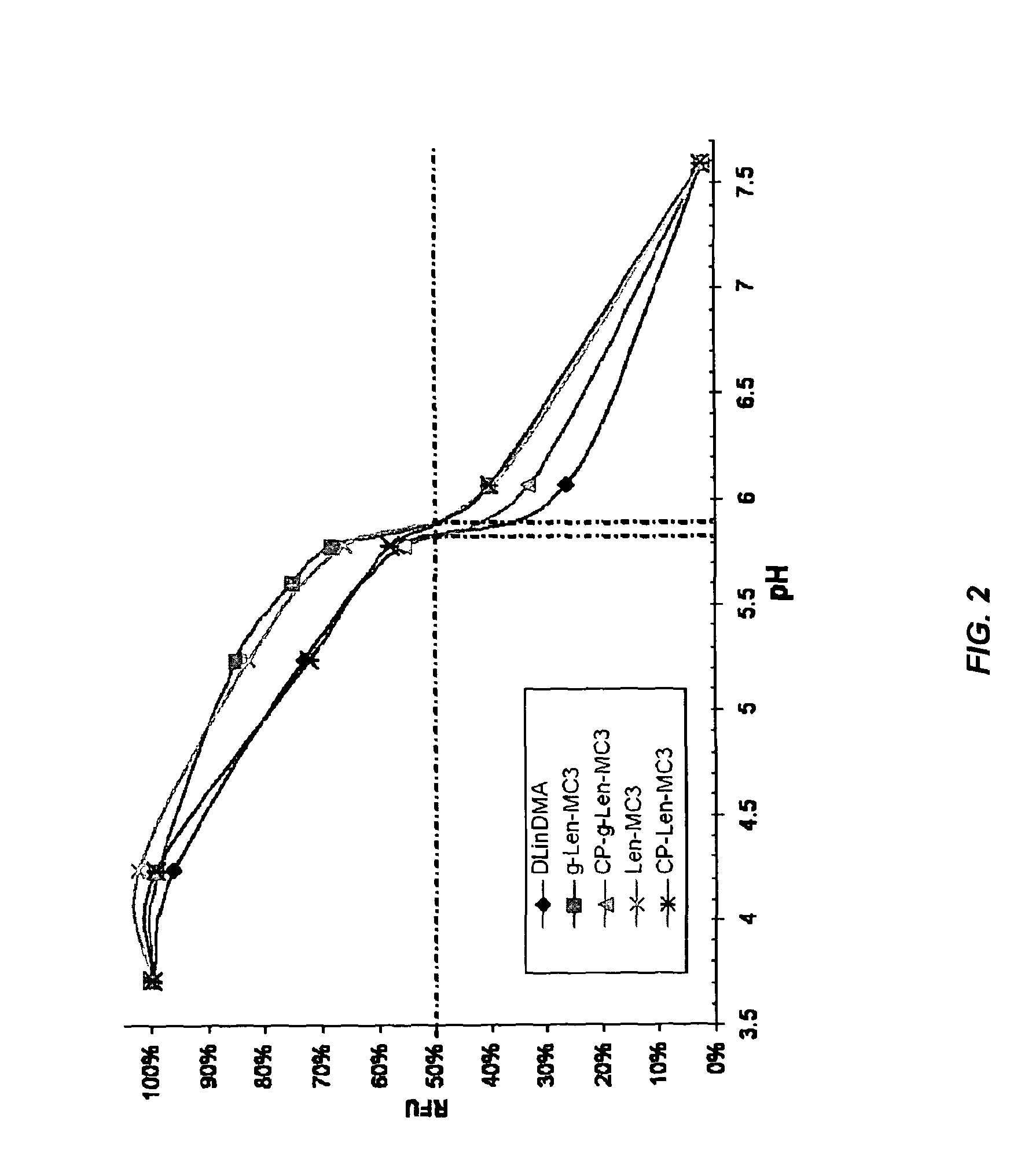Novel cyclic cationic lipids and methods of use
a lipid and cationic technology, applied in the field of new cyclic cationic lipids and methods of use, can solve the problems of reduced activity of the construct, reduced intracellular compartment access, and plasma nuclease susceptibility, and achieve the effect of stable circulation
- Summary
- Abstract
- Description
- Claims
- Application Information
AI Technical Summary
Benefits of technology
Problems solved by technology
Method used
Image
Examples
example 1
Synthesis of CP-DODMA
[0357]CP-DODMA (Compound 1) having the structure shown below was synthesized as described below.
[0358]A solution of DODMA (310 mg, 0.5 mmol) in anhydrous dichloromethane (10 mL) under nitrogen was cooled to 0° C. and a 1M solution of diethylzinc in hexanes (5 mL, 5 mmol, 5 eqv) added. The solution was stirred for 1 hour at 0° C. then diiodomethane (1.34 g, 404 μL, 5 mmol) was added and the solution was stirred for 16 hours at room temperature under nitrogen. TLC (8% MeOH in CHCl3) showed that the starting material was consumed and a very slightly more polar product had formed. The reaction mixture was concentrated and purified by column chromatography. A polar (lower running) impurity coeluted with the product. After concentrating appropriate column fractions they were dissolved in EtOAc and washed with 5% HCl (2×10 mL), water (10 mL), sat. NaHCO3 (10 mL), water (10 mL) and brine (10 mL). The solution was dried over MgSO4 and concentrated to afford a clear pale ...
example 2
Synthesis of CP-DPetroDMA
[0359]CP-DPetroDMA (Compound 2) having the structure shown below was synthesized as described below.
[0360]A solution of DPetroDMA (300 mg, 0.48 mmol) in anhydrous dichloromethane (10 mL) under nitrogen was cooled to 0° C. and a 1M solution of diethylzinc in hexanes (5 mL, 5 mmol, 5 eqv) added. The solution was stirred for 1 hour at 0° C. then diiodomethane (1.34 g, 404 μl, 5 mmol) was added and the solution was stirred overnight at room temperature under nitrogen. TLC (8% MeOH in CHCl3) showed that the starting material was consumed and a very slightly more polar product had formed. The reaction mixture was concentrated and purified by column chromatography. A polar (lower running) impurity coeluted with the product. After concentrating appropriate column fractions they were dissolved in EtOAc and washed with 5% HCl (2×10 mL), water (10 mL), sat. NaHCO3 (10 mL), water (10 mL) and brine (10 mL). The solution was dried over MgSO4 and concentrated to afford a c...
example 3
Synthesis of CP-DLinDMA
[0361]CP-DLinDMA (Compound 3) having the structure shown below was synthesized as described in Scheme 1 below.
ReagentMWAmountmmolEquivalents1DLinDMA615.06300mg0.4912Dichloromethane—20mL——3Diethylzinc 1M in—4.9mL4.910hexanes4Diiodomethane267.842.62g9.820(790μL)
[0362]To a solution of DLinDMA (300 mg, 0.49 mmol) in anhydrous dichloromethane (20 mL) cooled to 0° C. under nitrogen was added a 1M solution of diethylzinc in hexanes (4.9 mL). The solution was stirred for 1 hour at 0° C. then diiodomethane (2.62 g, 9.8 mmol) was added and the solution was stirred for 16 hours at room temperature under nitrogen. The solution was diluted with dichloromethane (20 mL), filtered and concentrated in vacuo to dryness. The residue was purified by column chromatography (10″ L×0.5″ D; eluted with 2.5% MeOH in CHCl3) to afford the product as a light yellow oil (288 mg, 87%). See also, Tanaka et al., Bioorg. Med. Chem. Lett., 13:1037-1040 (2003).
PUM
| Property | Measurement | Unit |
|---|---|---|
| Volume | aaaaa | aaaaa |
| Volume | aaaaa | aaaaa |
| Volume | aaaaa | aaaaa |
Abstract
Description
Claims
Application Information
 Login to View More
Login to View More - R&D
- Intellectual Property
- Life Sciences
- Materials
- Tech Scout
- Unparalleled Data Quality
- Higher Quality Content
- 60% Fewer Hallucinations
Browse by: Latest US Patents, China's latest patents, Technical Efficacy Thesaurus, Application Domain, Technology Topic, Popular Technical Reports.
© 2025 PatSnap. All rights reserved.Legal|Privacy policy|Modern Slavery Act Transparency Statement|Sitemap|About US| Contact US: help@patsnap.com



